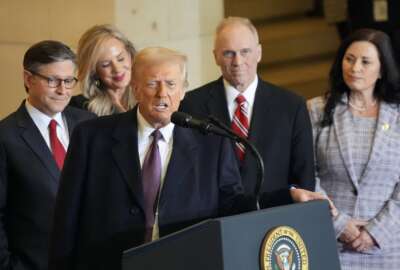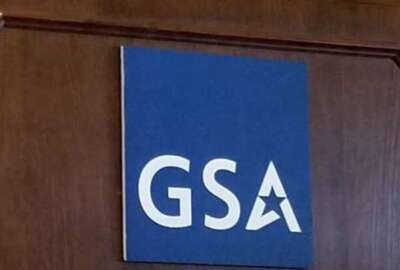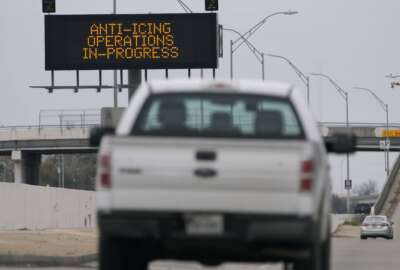Both parties already behind on presidential transition planning
No matter the election’s outcome, the “daunting” task of presidential transition planning is already going too slow, the Partnership for Public Service said.
Less than four months away from the November election, both major political parties are already behind on the massive undertaking of presidential transition planning.
With an incoming president’s work to make over 4,000 political appointments, manage a more than $6 trillion budget and oversee a workforce of more than 2 million people, the non-partisan, non-profit Partnership for Public Service described the task of transition planning as “daunting” — no matter the outcome of the election.
The sheer amount of work is all the more reason the planning needs to start sooner rather than later, Partnership leaders said during a press conference Thursday.
But preparations are slow to get underway. Republican presidential nominee Donald Trump and presumptive Democratic presidential nominee Kamala Harris both have yet to publicly name who will lead their transition teams over the next several months.
“That leadership should be somebody who is deeply trusted by the candidate, somebody who understands government in a fundamental way and somebody who is adept at building quickly organizational capability,” said Max Stier, the Partnership’s president and CEO. “They are both behind, and need to move with dispatch, if they are going to be able to fulfill truly the most fundamental function. Winning the campaign should not be the goal here. Governing effectively for the American people is what should be the goal.”
Planning a presidential transition ‘overwhelming’
In the months leading up to a president election, the preparation work piles high for presidential candidates and staff members of both political parties. That includes appointing a transition chairperson, organizing staff for a transition team, developing a project plan to guide that team through the process and establishing relationships with several government agencies and entities — and that’s just naming a few items on the to-do list.
As the sitting vice president and a former president, both major party nominees have some experience under their belt already for taking on the presidential transition process. But Stier said there’s still an “overwhelming” need to get to work on those preparations.
“There’s no way to overstate how challenging the transition preparation process actually is,” Stier said. “It’s the responsibility of whoever is the next president to keep us safe, to make sure that baton handoff is clean, clear and successful. And that requires deep, aggressive, thoughtful and capable planning to be able to do that.”
Ahead of the election this November, the General Services Administration has also been gearing up for a presidential transition. As required by a 2010 law, GSA has to help eligible party candidates after the nominating conventions to set up office space, equipment, IT and staff assistance as each party prepares for a possible transition into office.
The Office of Management and Budget began the transition process in April with a memo that set a series of deadlines for agencies to meet to ensure plans and efforts are in place no matter who wins the election. By Sept. 15, for instance, agency leaders must “ensure that a succession plan is in place for each senior non-career position in the agency.”
Anticipating surprises in the election cycle
The Partnership also relaunched its Center for Presidential Transition about one year out from the presidential election, with a goal of helping candidates through the process. Among many resources, the Partnership has updated its presidential transition guide, including a roadmap and advice from former transition teams on how to prepare.
Valerie Smith Boyd, director of the Partnership’s Center for Presidential Transition, said every new election cycle brings with it new surprises. Most recently, the COVID-19 pandemic largely shaped the transition planning that took place during the 2020 election cycle.
“Everybody was grappling with virtual technology in 2020, so that brought some challenges, too,” Smith Boyd said during Thursday’s press conference. “I think what we’ll see in 2024 is some sort of hybrid approach, with federal agencies deciding what to provide in person what to provide virtually or electronically.”
This time around, the Partnership is also anticipating new surprises, and likely difficulties, as each major party makes its way through transition preparations. The sluggishness to work through those preparations, though, is already a hindrance.
On the Republican side, conservative think tanks have been preparing various policy plans for the last couple of years, perhaps most notably the Heritage Foundation’s Project 2025. But until the Trump campaign authorizes a figure to integrate those prospective plans, Smith Boyd said “having multiple competing plans is just as difficult as having none.”
And for the Democratic party, following President Joe Biden’s recent decision to drop out of his re-election campaign, Harris’ late arrival as the prospective candidate puts her at somewhat of a disadvantage for planning the transition process.
“Through no fault of her own, the candidate has around half the time or two-thirds of the time that a presidential aspirant would normally have to assemble their own personnel and policy plans,” Smith Boyd said.
Harris, though, has some benefits of incumbency in the transition, Smith Boyd added. That also places her in a relatively rare position.
Impacts on political appointment process
A transition from a president to the sitting vice president has only happened a handful of times in U.S. history. The last time a vice president came in directly after a president was 1989, when George H.W. Bush succeeded Ronald Reagan. Before that, it was in 1929, when Herbert Hoover succeeded Calvin Coolidge.
A possible transition from a president to a sitting vice president also raises questions about the political appointment process. But it’s too early to say how or if that possible transition in January 2025 would follow the course of history.
Back in 1988, ahead of the presidential transition to Bush, Reagan asked for the resignation of all his top appointees, with the intention of giving Bush the flexibility to appoint whomever he chose for a Cabinet.
“Some of those people were asked back, but the entire process created some anxieties, some confusion and potentially resentment about people being asked back,” Smith Boyd said. “So, it is very important for the candidate’s team to develop a personnel strategy now that balances the benefits of incumbency with her strategic decisions.”
Additionally, calls from good government organizations have been growing, as they push for reforms to the presidential appointment and Senate confirmation processes on the whole.
With each successive administration, the process of confirming political nominees has grown longer and more difficult, the Partnership has said. The problem, exacerbated by a slowing Senate confirmation process, has worsened over time. The number of Senate-confirmed positions has grown by nearly 60% since 1960.
Currently, a new president has to fill more than 1,200 executive branch Senate-confirmed positions. That’s more than ever before, the Partnership said. Even now, with just months left in Biden’s presidential term, 96 politically appointed government positions still have no nominee, and the Senate is still considering 77 of Biden’s picks, according to a political appointee tracker run by the Partnership and the Washington Post.
The persistent vacancies in political leadership positions also threaten the government’s ability to operate at full tilt.
“Our Senate confirmation process is deeply broken, and as a result, it means that there are very long gaps between leadership in essential roles across our government.” Stier said. “You’re looking at confirmation times being three times longer, the Senate being dominated now by confirmation votes rather than legislation. You look at a miserable experience for nominees, and therefore the most qualified people that may not be willing to actually serve. And you look at the disruptions that take place inside the federal government because of the disjointed and absent leadership. It has enormous impacts.”
Civil servants’ role in a presidential transition
On the other hand, Smith Boyd said the resiliency and experience of career civil servants are major contributing factors to more effective presidential transitions.
“The longer they are in their seats, the more experience they have with changing priorities,” she said.
Expertise in the career federal workforce presents a “real opportunity” for political appointees who may come in during a new administration to work better and more effectively, Smith Boyd said.
It’s also an opportunity, she said, “for civil servants to listen for what appointees are trying to achieve and try to problem solve together — putting together their sense of urgency and optimism on one side, and the wisdom and experience on the other, to move policies forward for their agencies.”
But looming in the distance, a potential revival of Schedule F in a possible second Trump term is raising red flags for the Partnership, as it has for many other good government organizations. The now-revoked Schedule F executive order from Trump aimed to make certain career civil servants easier to fire, while opening up more positions for political appointees.
Stier called the idea of Schedule F “counterproductive” to the federal government’s ability to function effectively.
“Selecting political appointees themselves for loyalty over qualification — all those things are dangerous,” Stier said. “We’ll actually be in the opposite direction of where we need to go.”
Copyright © 2025 Federal News Network. All rights reserved. This website is not intended for users located within the European Economic Area.
Drew Friedman is a workforce, pay and benefits reporter for Federal News Network.
Follow @dfriedmanWFED






